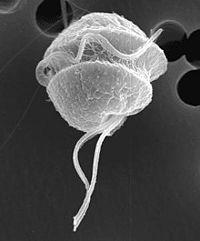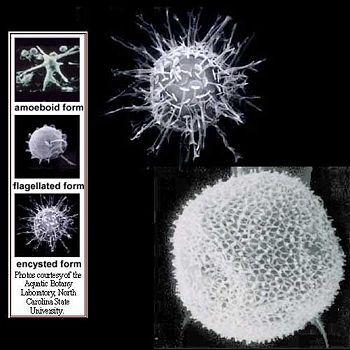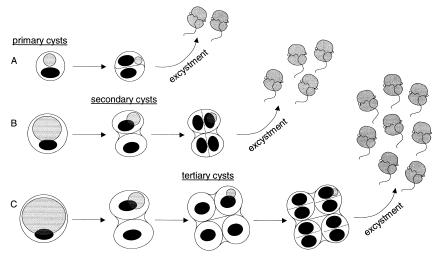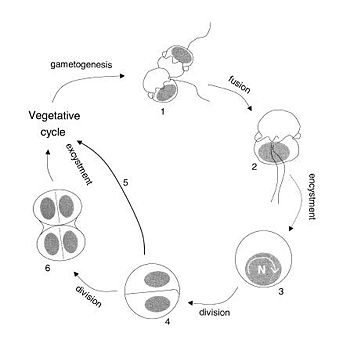Pfiesteria shumwayae
For the course duration, the article is closed to outside editing. Of course you can always leave comments on the discussion page. The anticipated date of course completion is May 21, 2009. One month after that date at the latest, this notice shall be removed. Besides, many other Citizendium articles welcome your collaboration! |
| Pfiesteria shumwayae | ||||||||||||||
|---|---|---|---|---|---|---|---|---|---|---|---|---|---|---|
 | ||||||||||||||
| Scientific classification | ||||||||||||||
|
Description and Significance
Pfiesteria shumwayae is a heterotrophic dinoflagellate belonging to the protist group pyrrophycophyta, or red algae. It was discovered by Dr. Burkholder at North Carolina State University in 1995. These dinoflagellates are found in warm coastal regions and temperate or tropical estuaries, and are known to cause massive fish kills via micropredation. It was once thought that fish kills in these areas were caused by exotoxin secretion by Pfiesteria, however recent research has shown that the parasitic feeding behavior of P. shumwayae is responsible for denuding fish of their epidermis and causing characteristic lesions on dead fish.[1] They also prey on other protists, shellfish tissue, and micro-algal species such as cryptomonads. P. shumwayae cysts and excysted offspring feed on the epidermis of live fish and free floating cells that detach from fish. Pfiesteria is known to exhibit both sexual and asexual reproduction, but asexual reproduction is most common among these dinoflagellates. Cite error: Closing </ref> missing for <ref> tag In the presence of live fish, P. shumwayae exhibits immediate chemotaxis to fish and gradually becomes toxic. According to research done by Glasgow et al. (2001), it was demonstrated that shortly after fish death, TOX-A strains of Pfiesteria ceased production of toxins and transformed into an amoeboid form that fed on dead fish remains. In the presence of other micro-algal prey, P. shumwayae reverted to the less toxic TOX-B form. Optimal temperature for toxicity is greater than or equal to 25°C.
Experiments were done that indicate toxic strains of P. shumwayae use exotoxins to weaken fish. They can also have effects on mammals as well. Toxins secreted by dinospores are similar to an ATP transmitter that targets the P2X7 receptor [2], causing a severe inflammatory response. Cultured fish exposed to Pfiesteria toxins showed signs of depression, loss of equilibrium, hyper-excitability and decreased respiration. The physical, epidermal damage done to fish by Pfiesteria is speculated to increase the efficiency of toxins into fish tissues. Some strains of Pfiesteria that are less toxic do not kill fish unless it has direct contact with its prey.[2]
Reproduction
P. shumwayae shares phylogenic relationships with and shows similar reproductive patterns to the marine diatom ectoparasite Paulsenella and of Amyloodinium. It usually reproduces using asexual fission but is known to exhibit a sexual life cycle as well. Cellular division takes place in non-motile cells, like cysts, that undergo regular mitosis as a diploid zygote. The zygote then undergoes meiosis which results in 2 to 8 bi-flagellated offspring (Parrow and Burkholder, 2003).
In response to unfavorable stimuli, P. shumwayae cells will feed and then become non-motile primary cysts. The size of the cyst depends on how much food material was ingested. When isolated culture populations were starved, cells resorted to cannibalism and senescent cysts occurred in smaller sizes (Parrow and Burkholder, 2003)
Asexual
Reproductive cysts were observed to have several protoplast divisions, internal to the plasma membrane which does not undergo division. (see diagram) The most common form of asexual reproduction of P. shumwayae cysts begins with a primary cyst. This primary cyst undergoes a protoplast division which can either result in two bi-flagellated offspring (A) or become a secondary cyst (B). The number of divisions and of offspring produced depends on the size of the primary cyst. The secondary cyst undergoes another protoplast division internal to the secondary cyst wall, releasing four bi-flagellated offspring (B). If the primary cyst was extremely large, the secondary cyst would undergo another protoplast division forming a tertiary cyst which releases eight bi-flagellated offspring (C). These divisions occur within several hours of each other. The food vacuole (represented by gray oval) present in the primary cyst is not divided amongst the offspring but grows smaller and is inherited by only one offspring (Parrow and Burkholder, 2003). It was observed that the offspring egested the food vacuole after excystment.
Sexual
In sexual reproduction of P. shumwayae, (see diagram below) two gametes fuse (1) to form a planozygote (2). The cell engages in nuclear cyclosis (3) which produces two flagellated offspring (4). Some of the steps in reproduction are unknown because of the difficulty researchers have in documenting information. The vegetative cells and the gametes look very similar, and fusion can easily be confused with division, making it difficult to differentiate between cycle phases (Parrow and Burkholder, 2003). That is why after nuclear cyclosis, it is unknown whether another division takes place before the excystment of offspring (5) and (6). According to Parrow and Burkholder’s research, reproduction in P. shumwayae seems to be unlinked to a survival strategy, and reverts to a sexual cycle because of self- sterility factors that favor outbreeding while taking advantage of food availability and environmental quality.
Ecology
Fish kills in warm coastal estuarine waters are usually attributed to harmful algal blooms of Pfiesteria. It is not typical for these blooms to occur after hurricanes and storms or in “high-wave-action, wind mixed” surface waters because Pfiesteria prefers calm, quiet water conditions, like poorly drained brackish water.[2] It is implicated that the stress of low oxygen and hypoxia in such waters is the primary cause of these manifestations.
Current Research
It has been established that Pfiesteria shumwayae kills fish by feeding on its epidermis. Research by Skelton, Burkholder and Parrow (2001), supports the idea that Pfiesteria is responsible for fish kills and lesions on wild fish due to myzocytosis and not so much exotoxin release. Many fish kills documented in their on- site field research show that non-inducible and temporarily non-toxic strains of Pfiesteria were present during kills and were not actively toxic. But Vogelbein et al. (2002) stated that there is some ambiguity of the role Pfiesteria plays in the mortality of wild fish due to pathogenicity via micro-predation versus exotoxin release. This conclusion is logical because in vitro assays sometimes cannot discriminate fish kills caused by exotoxins of toxic strains or myzocytosis. It can be suggested that more research be done to propose a definite conclusion to this issue however, retrieving substantial and accurate information on fish kills using traditional research methods is difficult for several reasons: 1). Pfiesteria zoospores change phases or life cycle stages, and may settle out of the water column making it harder to detect and quantify 2). Since these occurrences are in the form of blooms, they tend to be ephemeral and 3). There are Pfiesteria–like species present in the field that are morphologically similar to Pfiesteria, making it difficult for researchers to identify and distinguish one from the other.[2]
References
North Carolina Public Health. "Pfiesteria." 2006. North Carolina Department of Health and Public Services. 23 Apr. 2008. <http://www.epi.state.nc.us/epi/oee/pfie.html>
Parrow, M.W. and Burkholder, J.M. 2003. Reproduction and sexuality in Pfiesteria shumwayae (Dinophyceae). J. Phycol. 39:697-711.
Skelton, H.M., Burkholder, J.M. and Parrow, M.W. 2008. Axenic Cultivation of the Heterotrophic Dinoflagellate Pfiesteria shumwayae and Observations on Feeding Behavior. J. Phycol. 44:1614-1624.


